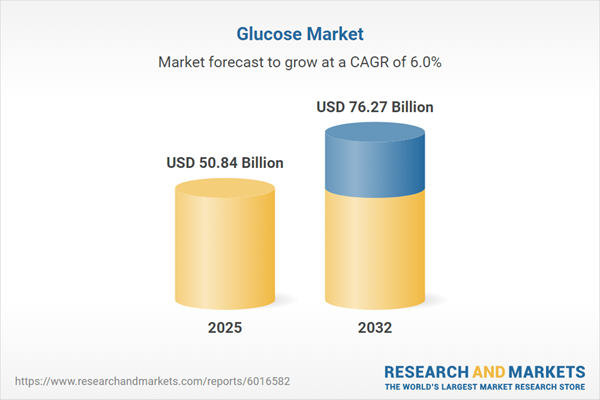Speak directly to the analyst to clarify any post sales queries you may have.
The glucose market is rapidly evolving as healthcare organizations face transformative technology, regulatory adjustments, and new care expectations. For senior leaders, this environment demands agile strategies that foster innovation and ensure security in disrupted supply chains.
Market Snapshot: Glucose Market Size and Growth Trajectory
The global glucose market grew from USD 48.03 billion in 2024 to USD 50.84 billion in 2025, reflecting a steady compound annual growth rate (CAGR) of 5.95%. This consistent expansion will likely continue, with projections estimating a market value of USD 76.27 billion by 2032. Momentum in this sector follows rising adoption of advanced glucose monitoring devices, increasing prevalence of diabetes worldwide, and the integration of real-time health analytics into clinical decision-making. As organizations aim for better patient outcomes, reliable glucose monitoring technologies anchor timely and data-driven interventions, defining the market’s forward trajectory.
Scope & Segmentation: Comprehensive Analysis for the Glucose Market
- Product Types: Continuous glucose monitoring offerings span real-time, intermittent scanning, implantable, and wearable devices. Additional tools, such as flash glucose monitors, lancets, meters, and test strips, ensure adaptability for various clinical and home-use scenarios.
- End Users: Key segments include diagnostic centers, specialty and general hospitals, diabetes clinics, and home care providers. Each presents unique integration needs and workflow requirements.
- Distribution Channels: Hospital pharmacies, traditional retail settings, and online platforms play crucial roles in facilitating access and supporting personalized service for professional and consumer end-users.
- Applications: The primary use remains diabetes management across gestational, type 1, and type 2 groups. Expanding utility in research and sports or fitness monitoring broadens the end-user base to encompass wellness, athletic, and research organizations.
- Technologies: Advancements include enzymatic sensors (amperometric, electrochemical), optical sensors (fluorescence, near-infrared), and transdermal microfluidic systems. Each technology addresses patient comfort, accuracy, and integration with digital systems.
- Regional Coverage: The glucose market covers the Americas, Europe, Middle East & Africa, and Asia-Pacific. Diverse growth drivers, such as reimbursement frameworks, local funding policies, and technological uptake, shape opportunity within each region.
- Key Players: Notable companies such as F. Hoffmann-La Roche AG, Abbott Diabetes Care Inc., Dexcom, Medtronic plc, LifeScan, Ascensia Diabetes Care Holdings AG, Senseonics Holdings, Nova Biomedical Corporation, Arkray, and Nipro Corporation influence market performance through product innovation and strategic partnerships.
Key Takeaways for Senior Decision-Makers
- Integrating glucose monitoring solutions with healthcare IT systems enables care teams to act on real-time data, supporting proactive patient management and early interventions.
- Smaller, user-friendly sensor designs reduce user resistance and enhance adherence, creating measurable improvements within both clinical and home environments.
- As remote and self-care glucose monitoring becomes more prevalent, the need to maintain oversight over data quality and device performance remains vital for organizations and providers.
- Digital distribution channels offer expanded reach and improve accessibility, while established in-person retail and hospital pharmacy networks continue to provide trusted patient support and education.
- Growing applications beyond diabetes—such as in sports, fitness, and research—encourage technological crossover and support new revenue streams for manufacturers and service providers.
- Collaborative efforts, including alliances in research, digital integration, and business mergers, enable organizations to remain agile and accelerate the introduction of new glucose solutions to the market.
Tariff Impact: Navigating Shifts in Supply Chain and Costs
Forthcoming tariff adjustments in the United States are expected to increase supply chain expenses, particularly for sensor technologies and electronic components sourced globally. To offset these pressures and safeguard supply reliability, many organizations are transitioning to more localized procurement strategies and expanding domestic device assembly. While these adaptive measures may influence short-term pricing and supplier agreements, they are expected to boost long-term supply chain resilience and provide diversified sourcing for stakeholders operating in the glucose market.
Methodology & Data Sources
This analysis draws from structured interviews with clinicians, device manufacturers, and health policy experts. Quantitative insights were gathered from validated public health data sets and proprietary logistics records. Findings underwent confirmation in expert workshops involving professionals from medical frontlines to ensure actionable results and reliability for the broader market.
Why This Report Matters
- Presents senior executives with a holistic view of the glucose monitoring market by capturing stakeholder perspectives and authenticated data.
- Outlines viable strategies to adjust for regulatory, technological, and competitive changes, strengthening positioning for future opportunities.
- Delivers actionable recommendations for investment planning, partnership exploration, and operational adaptation amid ongoing market transformation.
Conclusion
The glucose market demonstrates significant momentum and segmentation diversity. By utilizing the strategic insights in this report, leaders can confidently address shifting demands and seize new avenues for growth within a changing healthcare environment.
Additional Product Information:
- Purchase of this report includes 1 year online access with quarterly updates.
- This report can be updated on request. Please contact our Customer Experience team using the Ask a Question widget on our website.
Table of Contents
3. Executive Summary
4. Market Overview
7. Cumulative Impact of Artificial Intelligence 2025
Companies Mentioned
The companies profiled in this Glucose market report include:- F. Hoffmann-La Roche AG
- Abbott Diabetes Care Inc.
- Dexcom, Inc.
- Medtronic plc
- LifeScan, Inc.
- Ascensia Diabetes Care Holdings AG
- Senseonics Holdings, Inc.
- Nova Biomedical Corporation
- Arkray, Inc.
- Nipro Corporation
Table Information
| Report Attribute | Details |
|---|---|
| No. of Pages | 185 |
| Published | November 2025 |
| Forecast Period | 2025 - 2032 |
| Estimated Market Value ( USD | $ 50.84 Billion |
| Forecasted Market Value ( USD | $ 76.27 Billion |
| Compound Annual Growth Rate | 5.9% |
| Regions Covered | Global |
| No. of Companies Mentioned | 11 |









